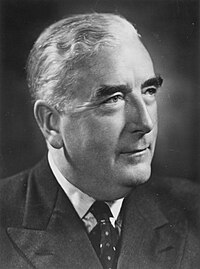Alex Hurabho
This article is incomplete because it is pending further input from participants, or it is a work-in-progress by one author. Please comment on this article's talk page to share your input, comments and questions. Note: To contribute to this article, you may need to seek help from the author(s) of this page. |
The Right Honourable Alex Hurabho | |
|---|---|
 | |
| Prime Minister of Scalizagasti | |
| In office 8 March 1942 – 15 November 1954 | |
| Preceded by | Julian Gisore |
| Succeeded by | Harvey Andrews |
| In office 9 June 1935 – 26 January 1939 | |
| Preceded by | Maxwell Hauke |
| Succeeded by | Julian Gisore |
| In office 16 January 1926 – 13 October 1933 | |
| Preceded by | Hugo Duponte |
| Succeeded by | Maxwell Hauke |
| Member of Parliament | |
| In office 21 October 1920 – 15 November 1954 | |
| Constituency | Dunedin |
| Leader of the Revolutionary Republican Party | |
| In office 16 January 1926 – 15 November 1957 | |
| Preceded by | Paul Donaldson (interim) |
| Succeeded by | Harvey Andrews |
| Personal details | |
| Born | 17 July 1882 Greenhill, Lamanges, Scalizagasti |
| Died | September 28, 1963 (aged 81) Chicoutimi, Lamanges, Scalizagasti |
| Political party | RRP |
| Alma mater | McSeross University Bewundal University |
George Alexander Hurabho (17 July 1882 – 28 September 1963) was a Scalizagastian lawyer, politician, and statesman who served as the Prime Minister of Scalizagasti for three non-consecutive periods from 1926–1933, 1935–1939, and 1942–1954. In total, he served for 23 years, the longest in Scalizagastian history. He became Prime Minister in 1926 when he was elected leader of the Revolutionary Republican Party following the resignation of Hugo Duponte. He was a major political figure in the country from the 1920s to the 1950s, still retaining great political influence after retiring from politics in 1954. Hurabho is best known for leading Scalizagasti during the Second Scalizi-Haprian War from 1946–1949 and implementing many new welfare programs such as universal healthcare and a national pension program.
Born in 1882 in the city of Greenhill, Lamanges, Hurabho graduated from McSeross University in Alesting and Bewundal University in Bewundal. He practiced law for most of his early professional career, before switching to politics in the 1920s. He was recruited by Republican leader Hugo Duponte to run for the RRP, winning a seat in the constituency of Dunedin in 1920. He would go on to win re-election in Dunedin eight more times until his early resignation in 1954.
Hurabho is one of the most influential leaders in Scalizagastian history as a result of his decades in office and expansive economic and political reform. A poll of political historians in 2011 named him the greatest Prime Minister, and public opinion polls consistenty rank him as one of the top three leaders of the country (and more often than not, in first place). His supporters point to the expansion of the welfare state and promotion of Scalizagastian unity during the Second Scalizi-Haprian War, alongside his personal charisma and political acumen, as evidence of his signficant legacy. Critics of Hurabho accused him of authoritarian tendencies during both his premiership and party leadership, especially during the war. Many polticians and members of the modern RRP claim to be Hurabhists, an ideology based on the "liberal nationalism" of Hurabho's premiership. After his death, many streets, buildings, and monuments were dedicated to the late leader, such as Hurabho International Airport in Bewundal.